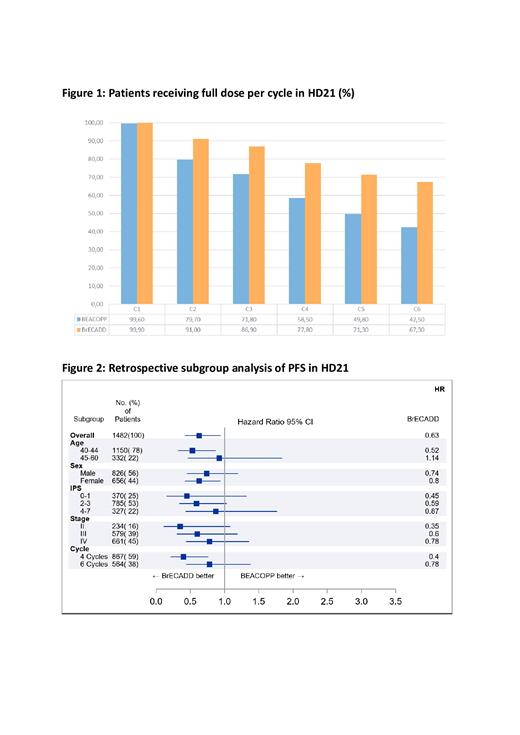INTRODUCTION
The GHSG-HD21 trial for newly diagnosed adult patients with advanced-stage classical Hodgkin lymphoma (AS-cHL) compares the BrECADD regimen (Brentuximab vedotin, etoposide, cyclophosphamide, doxorubicin, dacarbazine, dexamethasone) to eBEACOPP (bleomycin, etoposide, doxorubicin, cyclophosphamide, vincristine, procarbazine, prednisone) in a PET adapted approach. Separate analyses of the co-primary endpoints for tolerability and efficacy demonstrated a significant and relevant reduction in treatment-related morbidity (TRMB) and non-inferiority of PFS, respectively. Here, we report the first combined comprehensive analysis of the primary endpoints of the HD21 trial.
METHODS
This international open-label phase III trial included adult patients aged ≤ 60 yrs with AS-cHL. Patients were randomized in a 1:1 ratio to PET2-guided 4-6 21-day cycles of either eBEACOPP or BrECADD. PET2 and PFS events were assessed by blinded panel review. At a planned interim analysis at 36 months follow-up, the efficacy endpoint PFS was determined in the ITT cohort comprising 1,482 patients (eBEACOPP n=740, and BrECADD n=742) while the safety endpoint TRMB was determined in 1,470 patients (BEACOPP n=732, and BrECADD n=738). Subgroup analyses were calculated with 95% confidence intervals (Cis). The trial was registered at clinicaltrials.gov (NCT02661503) and conducted according to ICH-GCP guidelines.
RESULTS
Between July 2016 and August 2020, we enrolled 1,500 patients from 9 countries across 233 trial sites. Actual median follow-up for this analysis was 40 months. Baseline characteristics were well balanced between treatment arms, median age was 34 yrs (range 18-61), and 47% were high-risk (international prognostic index IPS ≥ 3).
Overall, the relative risk for a TRMB event was 0.72 (95% CI, 0.65-0.79) in favor of BrECADD. Subgroup analyses confirmed a consistent, highly significant TRMB benefit in all relevant subgroups. Dose reductions were required less frequently with BrECADD than with eBEACOPP (figure 1); full dose treatment at cycle 4 was administered in 58.5% of patients in the eBEACOPP group compared to 77.8% in the BrECADD group. In PET2-positive patients at cycle 6, full dose treatment was received by 42.5% in the eBEACOPP group versus 67.3% in the BrECADD group. Most frequent reasons for dose reductions were leukopenia for eBEACOPP (in 33.7% of patients) and thrombocytopenia for BrECADD (in 23.1 % of patients).
59% of patients achieved a PET2-negative response and were treated with a total of 4 cycles in each group; conversely, 41% of patients were PET2-positive and received 6 cycles. At the end of treatment with either 4 or 6 cycles, a complete metabolic response was seen in 80% and 82% of patients in the eBEACOPP and BrECADD cohorts, respectively. The 3-yr PFS was 94.9% for BrECADD (95% CI 93.5% - 96.7%), and 92.3% for eBEACOPP (95% CI 90.3% - 94.3%), with a corresponding HR of 0.63 (95% CI 0.42-0.94). A HR favoring BrECADD was consistently observed across all relevant subgroups (figure 2). Notably, HRs favoring BrECADD were generally lower in lower-risk cohorts including IPS (0, 1; 2, 3; 4-7: HR 0.45, 0.59, 0.87, respectively), stage (Ann-Arbor stage II, III, IV: HR 0.35, 0.6, 0.78, respectively), or PET-2 response (negative versus positive, HR 0.4, 95% CI 0.21-0.76 vs 0.78, 95% CI 0.44-1.38). Corresponding 3-yr PFS rates for BrECADD versus eBEACOPP were 97.1% (95% CI 95.5% - 98.7%) versus 93.6% (95% CI 91.3% - 95.9%) for PET2-negative patients and 93.5% (95% CI 90.6% - 96.5%) versus 90.6% (95% CI 87.1% - 94.1%) for PET2-positive patients, respectively.
CONCLUSION
With the novel BrECADD regimen, we observed the highest 3-yr PFS rates reported to date in a randomized clinical trial in advanced-stage cHL. Our analyses suggest that the unexpectedly high and improved efficacy of the new BrECADD regimen compared to eBEACOPP is a direct consequence of its improved tolerability and deliverability. Importantly, while the larger patient cohort of PET2-negative patients achieves a very high 3-yr PFS of 97% with a very short and safe 12-week treatment, this benefit was also observed for PET2-positive patients. In conclusion, the optimized risk-benefit ratio of the BrECADD regimen combined with the individualized PET2-guided treatment duration sets a new benchmark for the treatment of adult patients with newly diagnosed advanced stage cHL
OffLabel Disclosure:
Borchmann:Bristol-Myers Squibb: Consultancy; Merck Sharp & Dohme: Consultancy, Research Funding; Roche: Consultancy, Research Funding; Novartis: Consultancy, Research Funding; Amgen: Consultancy, Research Funding; Takeda Oncology: Consultancy, Research Funding; MPI: Research Funding. Greil:Roche: Honoraria, Research Funding. Hänel:Novartis, SOBI, Gilead, Falk Foundation: Honoraria; Novartis, BMS/Celgene, Gilead, Pfizer, Incyte, Sanofi/Aventis, Roche, Amgen, SOBI, Janssen: Consultancy. Novak:Novartis: Other: Advisory Boards; Gilead: Other: Advisory Boards; BMS: Other: Advisory Board. Viardot:F. Hoffmann-La Roche Ltd, Abbvie, Kite/Gilead, BMS: Honoraria; BMS: Research Funding; F. Hoffmann-La Roche Ltd, Abbvie, Kite/Gilead, BMS: Consultancy. Giri:Royal Adelaide Hospital: Current Employment. Molin:MSD: Honoraria; Roche: Honoraria; BMS: Honoraria; Takeda: Honoraria. Ferdinandus:Roche: Honoraria. Hallek:Abbvie: Consultancy, Honoraria, Research Funding; Roche: Consultancy, Honoraria, Research Funding; Janssen: Consultancy, Honoraria, Research Funding; AstraZeneca: Consultancy, Honoraria, Research Funding; BeiGene: Consultancy, Honoraria, Research Funding; Gilead: Consultancy, Honoraria, Research Funding.
USe of Brentuximab vedotin in combination with etoposide, cyclophosphamide, doxorubicin, dacarbazine, dexamethasone for advacned stage classical HL


